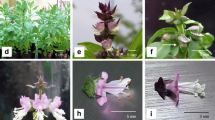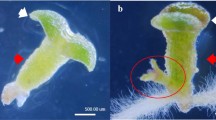Summary
All accessions tested of four cultivated species ofCucurbita responded to seedling treatment with 250 ppm 2-chloroethylphosphonic acid by developing only pistillate flowers for an extended period. This growth regulator is a promising means of facilitating hybrid seed production of squash. A similar treatment did not induce flowering of wild species ofCucurbita that were vegetative under the environmental conditions of the experiment.
Similar content being viewed by others
References
Bushnell, J. W., 1922. Isolation of uniform types of Hubbard squash by inbreeding. Proc. Am. Soc. Hort. Sci. 19: 139–144.
Cummings, M. B. &Jenkins, E. W., 1928. Pure line studies with ten generations of Hubbard squash. Vt. Agr. Expt. Sta. Bull. 280, 29 pp.
Cummings, M. B. &Stone, W. C., 1921. Yield and quality in Hubbard squash. Vt. Agr. Expt. Sta. Bull. 222, 48 pp.
Curtis, L. C., 1939. Heterosis in summer squash (Cucurbita pepo) and the possibilities of producing. F1 hybrid seed for commercial planting. Proc. Am. Soc. Hort. Sci. 37: 827–828.
Curtis, L. C., 1941. Comparative earliness and productiveness of first and second generation summer squash (Curcurbita pepo) and the possibilities of using the second generation for commercial planting. Proc. Am. Soc. Hort. Sci. 38: 596–598.
Curtis, L. C., 1942. Yankee hybrid summer squash, an early productive first generation cross. Conn. Agr. Expt. Sta. Circ. 152: 61–65.
Haber, E. S., 1928. Inbreeding in the Table Queen (Des Moines) squash. Proc. Am. Soc. Hort. Sci. 25: 111–114.
Hayase, H. &Ueda, T., 1956.Cucurbita crosses. IX. Hybrid vigor of reciprocal F1 crosses inCucurbita maxima. Hokkaido Natl. Agr. Sta. Res. Bull. 71: 119–128.
Hutchins, A. E. &Croston, F. E., 1941. Productivity of F1 hybrids in squash (Cucurbita maxima). Proc. Am. Soc. Hort. Sci. 39: 332–336.
Robinson, R. W., Shannon, S. &Guardia, M. de la, 1969. Regulation of sex expression in the cucumber. BioScience 19: 141–142.
Scott, G. W., 1934. Observations on some inbred lines of bush types ofCucurbita pepo. Proc. Am. Soc. Hort. Sci. 32: 480.
Singh, D., 1949. Inheritance of certain economic characters in the squash,Cucurbita maxima Duch. Minn. Agr. Expt. Sta. Tech. Bull. 186, 30 pp.
U.S. Dept. Agr. Statistical Reporting Service, 1969. Vegetable Seed Reports, 8 pp.
Author information
Authors and Affiliations
Additional information
Approved by the Director of the New York State Agricultural Experiment Station for publication as Journal Paper No. 1737.
Rights and permissions
About this article
Cite this article
Robinson, R.W., Whitaker, T.W. & Bohn, G.W. Promotion of pistillate flowering inCucurbita by 2-chloroethylphosphonic acid. Euphytica 19, 180–183 (1970). https://doi.org/10.1007/BF01902942
Received:
Issue Date:
DOI: https://doi.org/10.1007/BF01902942




